Financial Resource Management Report: Cost, Volume, Profit Analysis
VerifiedAdded on 2021/01/01
|8
|1976
|241
Report
AI Summary
This report, prepared for "New Horizons Accountants Ltd," provides a comprehensive overview of financial resource management, focusing on cost analysis, Cost-Volume-Profit (CVP) analysis, and break-even analysis. It begins by classifying various cost types, including fixed, variable, and semi-variable costs, and categorizing them based on management capacity, traceability, time, and decision-making perspectives. The report then explains the concept of CVP analysis and its application in determining the break-even point, profit calculations at different sales levels, and the impact of changes in sales commissions and salaries. It includes practical examples and calculations to illustrate the concepts, such as the calculation of profit or loss at different production levels and the impact of increased commissions and salaries on profitability and the break-even point. The report concludes by emphasizing the importance of financial resource management for organizational success and provides references to relevant literature.
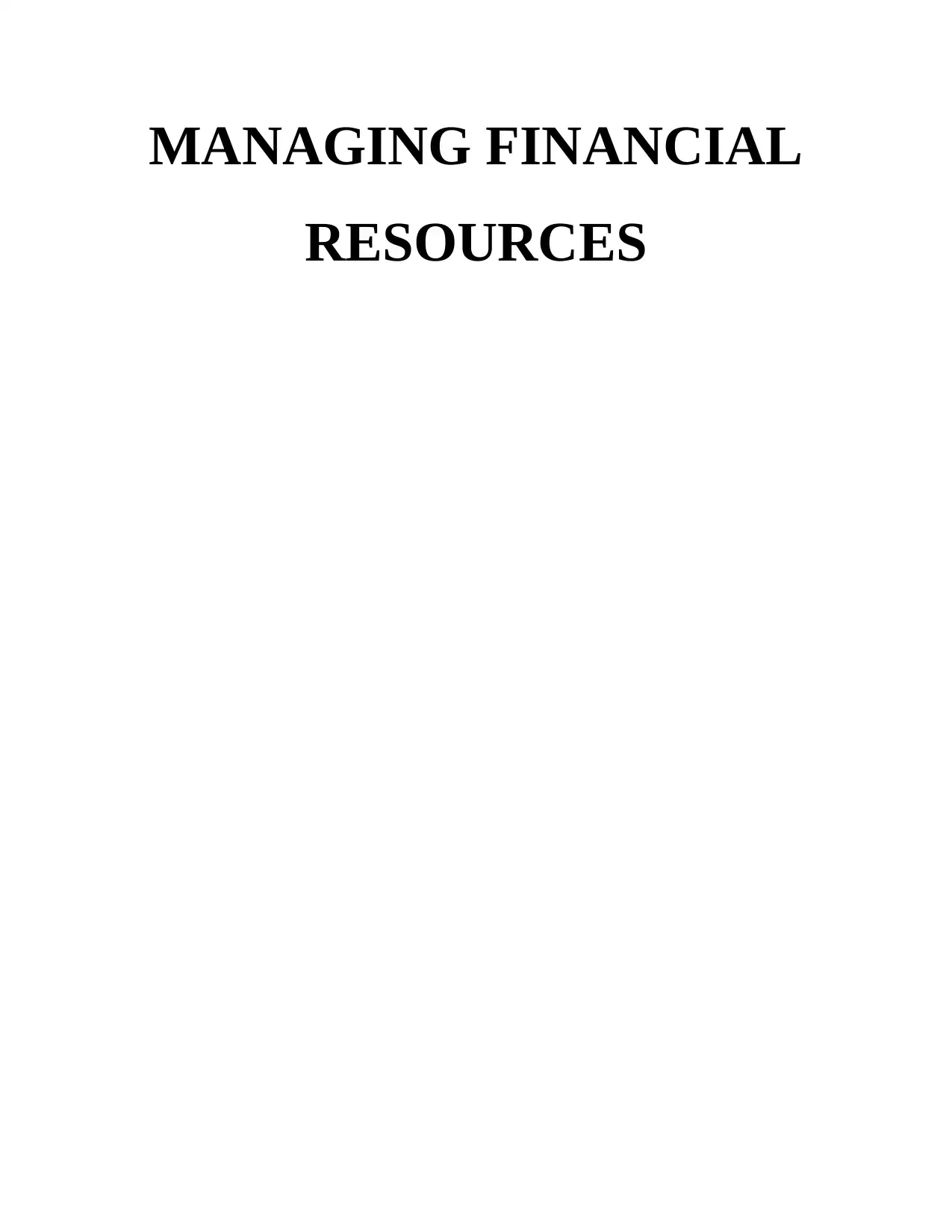
MANAGING FINANCIAL
RESOURCES
RESOURCES
Paraphrase This Document
Need a fresh take? Get an instant paraphrase of this document with our AI Paraphraser
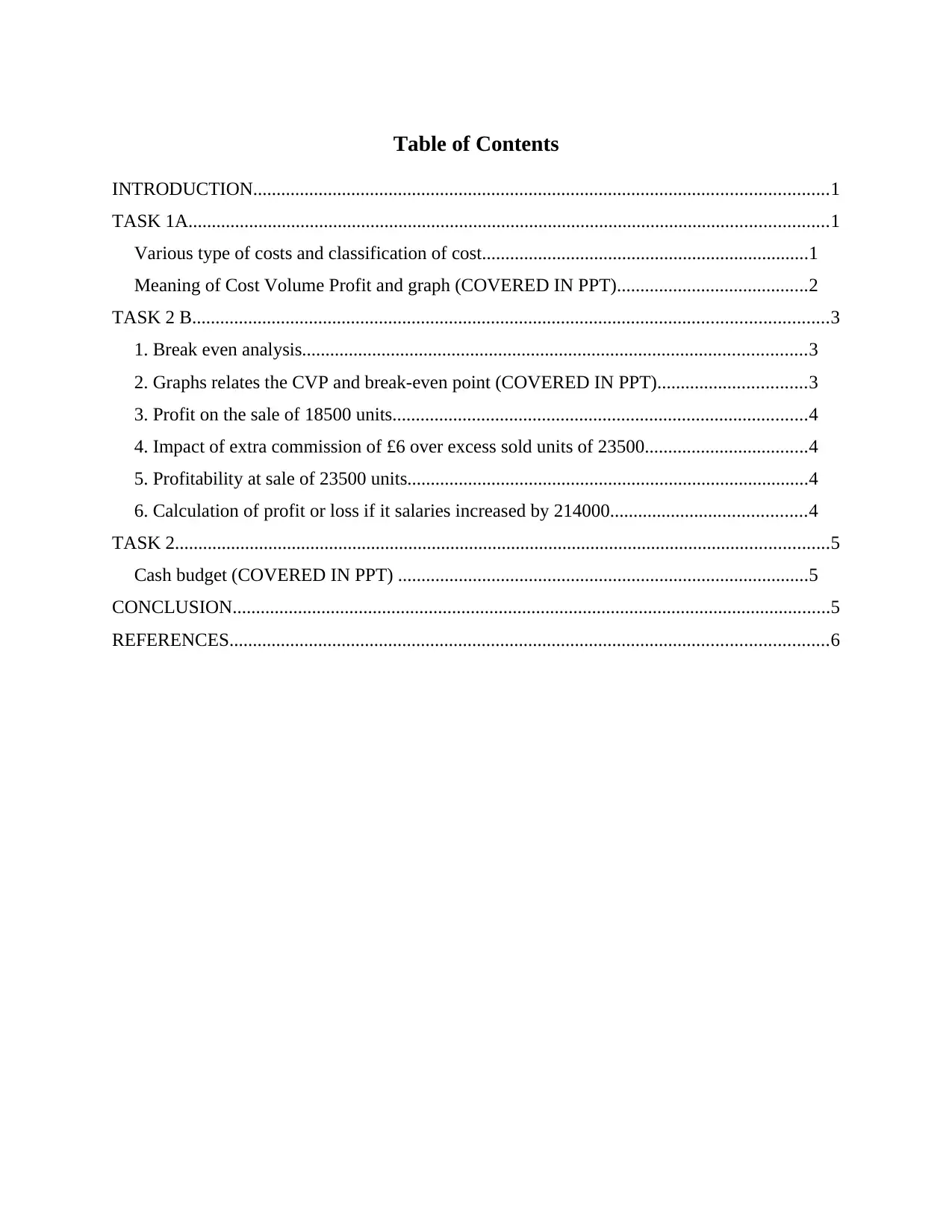
Table of Contents
INTRODUCTION...........................................................................................................................1
TASK 1A.........................................................................................................................................1
Various type of costs and classification of cost......................................................................1
Meaning of Cost Volume Profit and graph (COVERED IN PPT).........................................2
TASK 2 B........................................................................................................................................3
1. Break even analysis............................................................................................................3
2. Graphs relates the CVP and break-even point (COVERED IN PPT)................................3
3. Profit on the sale of 18500 units.........................................................................................4
4. Impact of extra commission of £6 over excess sold units of 23500...................................4
5. Profitability at sale of 23500 units......................................................................................4
6. Calculation of profit or loss if it salaries increased by 214000..........................................4
TASK 2............................................................................................................................................5
Cash budget (COVERED IN PPT) ........................................................................................5
CONCLUSION................................................................................................................................5
REFERENCES................................................................................................................................6
INTRODUCTION...........................................................................................................................1
TASK 1A.........................................................................................................................................1
Various type of costs and classification of cost......................................................................1
Meaning of Cost Volume Profit and graph (COVERED IN PPT).........................................2
TASK 2 B........................................................................................................................................3
1. Break even analysis............................................................................................................3
2. Graphs relates the CVP and break-even point (COVERED IN PPT)................................3
3. Profit on the sale of 18500 units.........................................................................................4
4. Impact of extra commission of £6 over excess sold units of 23500...................................4
5. Profitability at sale of 23500 units......................................................................................4
6. Calculation of profit or loss if it salaries increased by 214000..........................................4
TASK 2............................................................................................................................................5
Cash budget (COVERED IN PPT) ........................................................................................5
CONCLUSION................................................................................................................................5
REFERENCES................................................................................................................................6
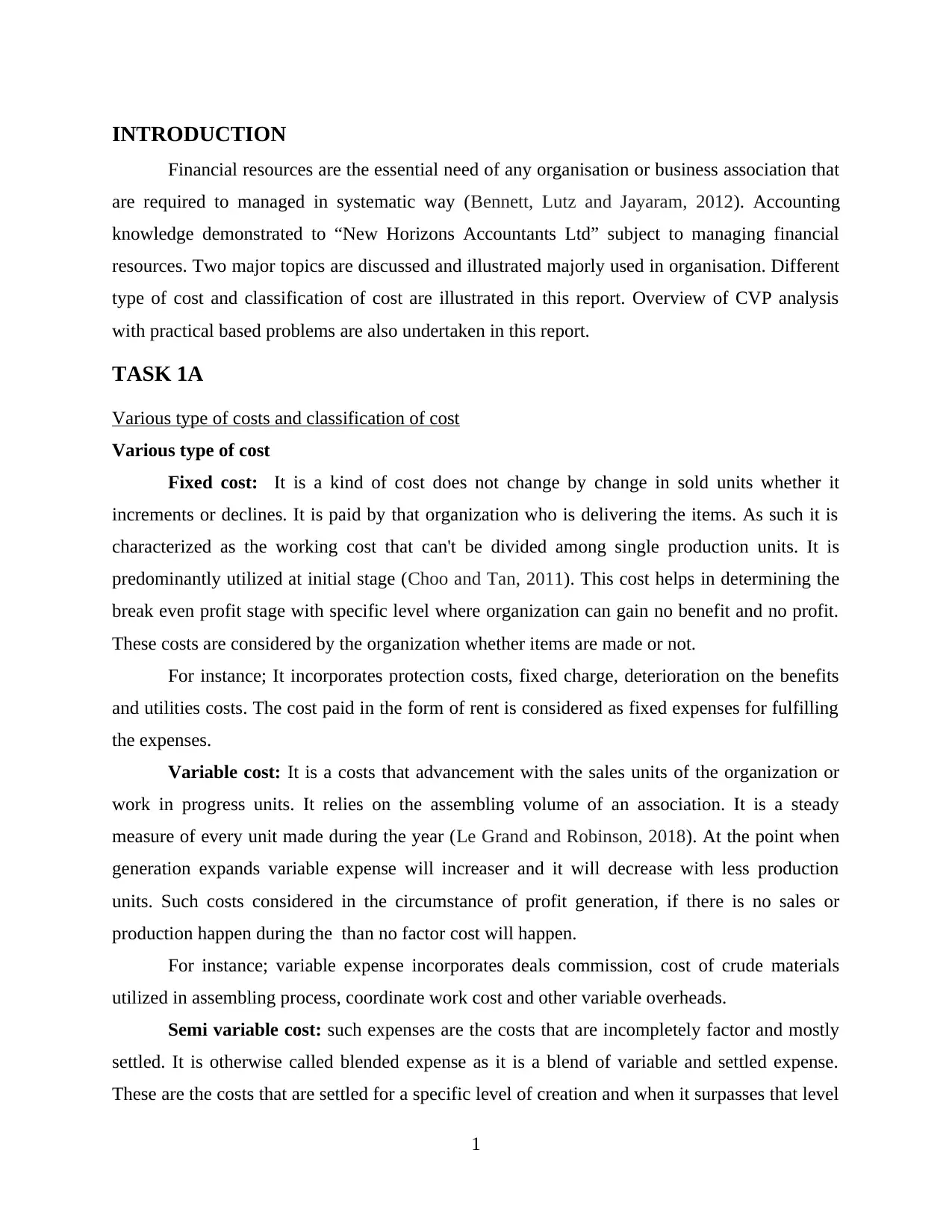
INTRODUCTION
Financial resources are the essential need of any organisation or business association that
are required to managed in systematic way (Bennett, Lutz and Jayaram, 2012). Accounting
knowledge demonstrated to “New Horizons Accountants Ltd” subject to managing financial
resources. Two major topics are discussed and illustrated majorly used in organisation. Different
type of cost and classification of cost are illustrated in this report. Overview of CVP analysis
with practical based problems are also undertaken in this report.
TASK 1A
Various type of costs and classification of cost
Various type of cost
Fixed cost: It is a kind of cost does not change by change in sold units whether it
increments or declines. It is paid by that organization who is delivering the items. As such it is
characterized as the working cost that can't be divided among single production units. It is
predominantly utilized at initial stage (Choo and Tan, 2011). This cost helps in determining the
break even profit stage with specific level where organization can gain no benefit and no profit.
These costs are considered by the organization whether items are made or not.
For instance; It incorporates protection costs, fixed charge, deterioration on the benefits
and utilities costs. The cost paid in the form of rent is considered as fixed expenses for fulfilling
the expenses.
Variable cost: It is a costs that advancement with the sales units of the organization or
work in progress units. It relies on the assembling volume of an association. It is a steady
measure of every unit made during the year (Le Grand and Robinson, 2018). At the point when
generation expands variable expense will increaser and it will decrease with less production
units. Such costs considered in the circumstance of profit generation, if there is no sales or
production happen during the than no factor cost will happen.
For instance; variable expense incorporates deals commission, cost of crude materials
utilized in assembling process, coordinate work cost and other variable overheads.
Semi variable cost: such expenses are the costs that are incompletely factor and mostly
settled. It is otherwise called blended expense as it is a blend of variable and settled expense.
These are the costs that are settled for a specific level of creation and when it surpasses that level
1
Financial resources are the essential need of any organisation or business association that
are required to managed in systematic way (Bennett, Lutz and Jayaram, 2012). Accounting
knowledge demonstrated to “New Horizons Accountants Ltd” subject to managing financial
resources. Two major topics are discussed and illustrated majorly used in organisation. Different
type of cost and classification of cost are illustrated in this report. Overview of CVP analysis
with practical based problems are also undertaken in this report.
TASK 1A
Various type of costs and classification of cost
Various type of cost
Fixed cost: It is a kind of cost does not change by change in sold units whether it
increments or declines. It is paid by that organization who is delivering the items. As such it is
characterized as the working cost that can't be divided among single production units. It is
predominantly utilized at initial stage (Choo and Tan, 2011). This cost helps in determining the
break even profit stage with specific level where organization can gain no benefit and no profit.
These costs are considered by the organization whether items are made or not.
For instance; It incorporates protection costs, fixed charge, deterioration on the benefits
and utilities costs. The cost paid in the form of rent is considered as fixed expenses for fulfilling
the expenses.
Variable cost: It is a costs that advancement with the sales units of the organization or
work in progress units. It relies on the assembling volume of an association. It is a steady
measure of every unit made during the year (Le Grand and Robinson, 2018). At the point when
generation expands variable expense will increaser and it will decrease with less production
units. Such costs considered in the circumstance of profit generation, if there is no sales or
production happen during the than no factor cost will happen.
For instance; variable expense incorporates deals commission, cost of crude materials
utilized in assembling process, coordinate work cost and other variable overheads.
Semi variable cost: such expenses are the costs that are incompletely factor and mostly
settled. It is otherwise called blended expense as it is a blend of variable and settled expense.
These are the costs that are settled for a specific level of creation and when it surpasses that level
1
⊘ This is a preview!⊘
Do you want full access?
Subscribe today to unlock all pages.

Trusted by 1+ million students worldwide
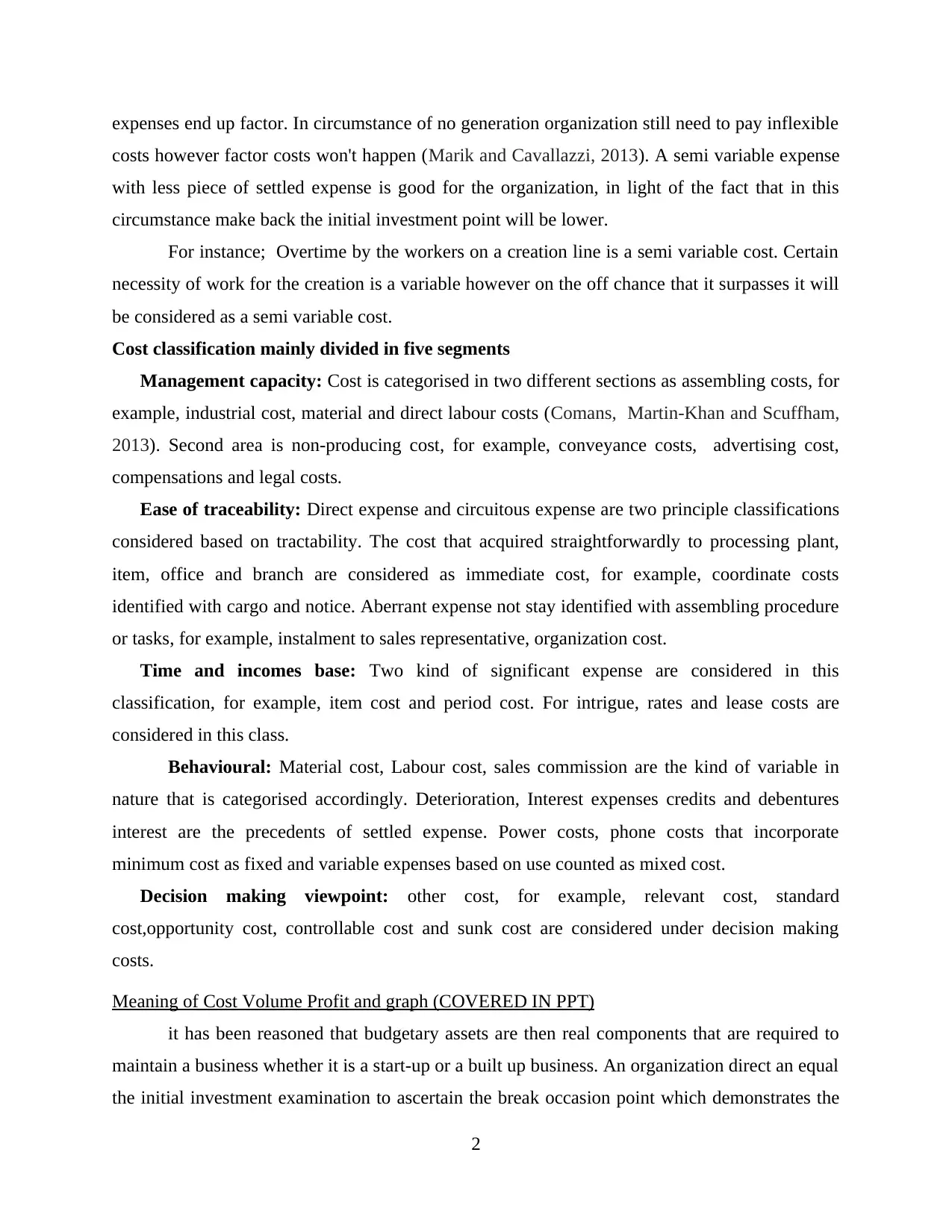
expenses end up factor. In circumstance of no generation organization still need to pay inflexible
costs however factor costs won't happen (Marik and Cavallazzi, 2013). A semi variable expense
with less piece of settled expense is good for the organization, in light of the fact that in this
circumstance make back the initial investment point will be lower.
For instance; Overtime by the workers on a creation line is a semi variable cost. Certain
necessity of work for the creation is a variable however on the off chance that it surpasses it will
be considered as a semi variable cost.
Cost classification mainly divided in five segments
Management capacity: Cost is categorised in two different sections as assembling costs, for
example, industrial cost, material and direct labour costs (Comans, Martin-Khan and Scuffham,
2013). Second area is non-producing cost, for example, conveyance costs, advertising cost,
compensations and legal costs.
Ease of traceability: Direct expense and circuitous expense are two principle classifications
considered based on tractability. The cost that acquired straightforwardly to processing plant,
item, office and branch are considered as immediate cost, for example, coordinate costs
identified with cargo and notice. Aberrant expense not stay identified with assembling procedure
or tasks, for example, instalment to sales representative, organization cost.
Time and incomes base: Two kind of significant expense are considered in this
classification, for example, item cost and period cost. For intrigue, rates and lease costs are
considered in this class.
Behavioural: Material cost, Labour cost, sales commission are the kind of variable in
nature that is categorised accordingly. Deterioration, Interest expenses credits and debentures
interest are the precedents of settled expense. Power costs, phone costs that incorporate
minimum cost as fixed and variable expenses based on use counted as mixed cost.
Decision making viewpoint: other cost, for example, relevant cost, standard
cost,opportunity cost, controllable cost and sunk cost are considered under decision making
costs.
Meaning of Cost Volume Profit and graph (COVERED IN PPT)
it has been reasoned that budgetary assets are then real components that are required to
maintain a business whether it is a start-up or a built up business. An organization direct an equal
the initial investment examination to ascertain the break occasion point which demonstrates the
2
costs however factor costs won't happen (Marik and Cavallazzi, 2013). A semi variable expense
with less piece of settled expense is good for the organization, in light of the fact that in this
circumstance make back the initial investment point will be lower.
For instance; Overtime by the workers on a creation line is a semi variable cost. Certain
necessity of work for the creation is a variable however on the off chance that it surpasses it will
be considered as a semi variable cost.
Cost classification mainly divided in five segments
Management capacity: Cost is categorised in two different sections as assembling costs, for
example, industrial cost, material and direct labour costs (Comans, Martin-Khan and Scuffham,
2013). Second area is non-producing cost, for example, conveyance costs, advertising cost,
compensations and legal costs.
Ease of traceability: Direct expense and circuitous expense are two principle classifications
considered based on tractability. The cost that acquired straightforwardly to processing plant,
item, office and branch are considered as immediate cost, for example, coordinate costs
identified with cargo and notice. Aberrant expense not stay identified with assembling procedure
or tasks, for example, instalment to sales representative, organization cost.
Time and incomes base: Two kind of significant expense are considered in this
classification, for example, item cost and period cost. For intrigue, rates and lease costs are
considered in this class.
Behavioural: Material cost, Labour cost, sales commission are the kind of variable in
nature that is categorised accordingly. Deterioration, Interest expenses credits and debentures
interest are the precedents of settled expense. Power costs, phone costs that incorporate
minimum cost as fixed and variable expenses based on use counted as mixed cost.
Decision making viewpoint: other cost, for example, relevant cost, standard
cost,opportunity cost, controllable cost and sunk cost are considered under decision making
costs.
Meaning of Cost Volume Profit and graph (COVERED IN PPT)
it has been reasoned that budgetary assets are then real components that are required to
maintain a business whether it is a start-up or a built up business. An organization direct an equal
the initial investment examination to ascertain the break occasion point which demonstrates the
2
Paraphrase This Document
Need a fresh take? Get an instant paraphrase of this document with our AI Paraphraser
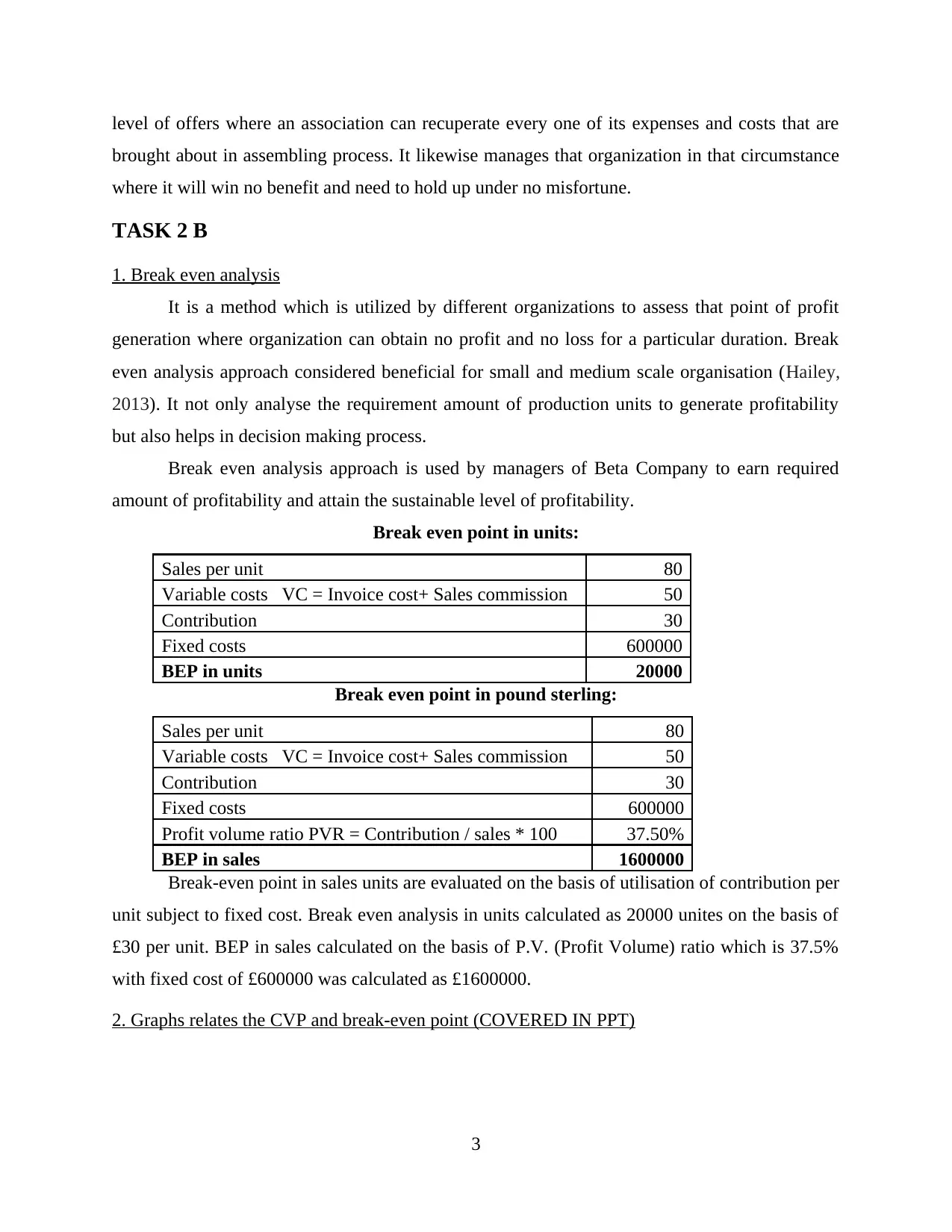
level of offers where an association can recuperate every one of its expenses and costs that are
brought about in assembling process. It likewise manages that organization in that circumstance
where it will win no benefit and need to hold up under no misfortune.
TASK 2 B
1. Break even analysis
It is a method which is utilized by different organizations to assess that point of profit
generation where organization can obtain no profit and no loss for a particular duration. Break
even analysis approach considered beneficial for small and medium scale organisation (Hailey,
2013). It not only analyse the requirement amount of production units to generate profitability
but also helps in decision making process.
Break even analysis approach is used by managers of Beta Company to earn required
amount of profitability and attain the sustainable level of profitability.
Break even point in units:
Sales per unit 80
Variable costs VC = Invoice cost+ Sales commission 50
Contribution 30
Fixed costs 600000
BEP in units 20000
Break even point in pound sterling:
Sales per unit 80
Variable costs VC = Invoice cost+ Sales commission 50
Contribution 30
Fixed costs 600000
Profit volume ratio PVR = Contribution / sales * 100 37.50%
BEP in sales 1600000
Break-even point in sales units are evaluated on the basis of utilisation of contribution per
unit subject to fixed cost. Break even analysis in units calculated as 20000 unites on the basis of
£30 per unit. BEP in sales calculated on the basis of P.V. (Profit Volume) ratio which is 37.5%
with fixed cost of £600000 was calculated as £1600000.
2. Graphs relates the CVP and break-even point (COVERED IN PPT)
3
brought about in assembling process. It likewise manages that organization in that circumstance
where it will win no benefit and need to hold up under no misfortune.
TASK 2 B
1. Break even analysis
It is a method which is utilized by different organizations to assess that point of profit
generation where organization can obtain no profit and no loss for a particular duration. Break
even analysis approach considered beneficial for small and medium scale organisation (Hailey,
2013). It not only analyse the requirement amount of production units to generate profitability
but also helps in decision making process.
Break even analysis approach is used by managers of Beta Company to earn required
amount of profitability and attain the sustainable level of profitability.
Break even point in units:
Sales per unit 80
Variable costs VC = Invoice cost+ Sales commission 50
Contribution 30
Fixed costs 600000
BEP in units 20000
Break even point in pound sterling:
Sales per unit 80
Variable costs VC = Invoice cost+ Sales commission 50
Contribution 30
Fixed costs 600000
Profit volume ratio PVR = Contribution / sales * 100 37.50%
BEP in sales 1600000
Break-even point in sales units are evaluated on the basis of utilisation of contribution per
unit subject to fixed cost. Break even analysis in units calculated as 20000 unites on the basis of
£30 per unit. BEP in sales calculated on the basis of P.V. (Profit Volume) ratio which is 37.5%
with fixed cost of £600000 was calculated as £1600000.
2. Graphs relates the CVP and break-even point (COVERED IN PPT)
3
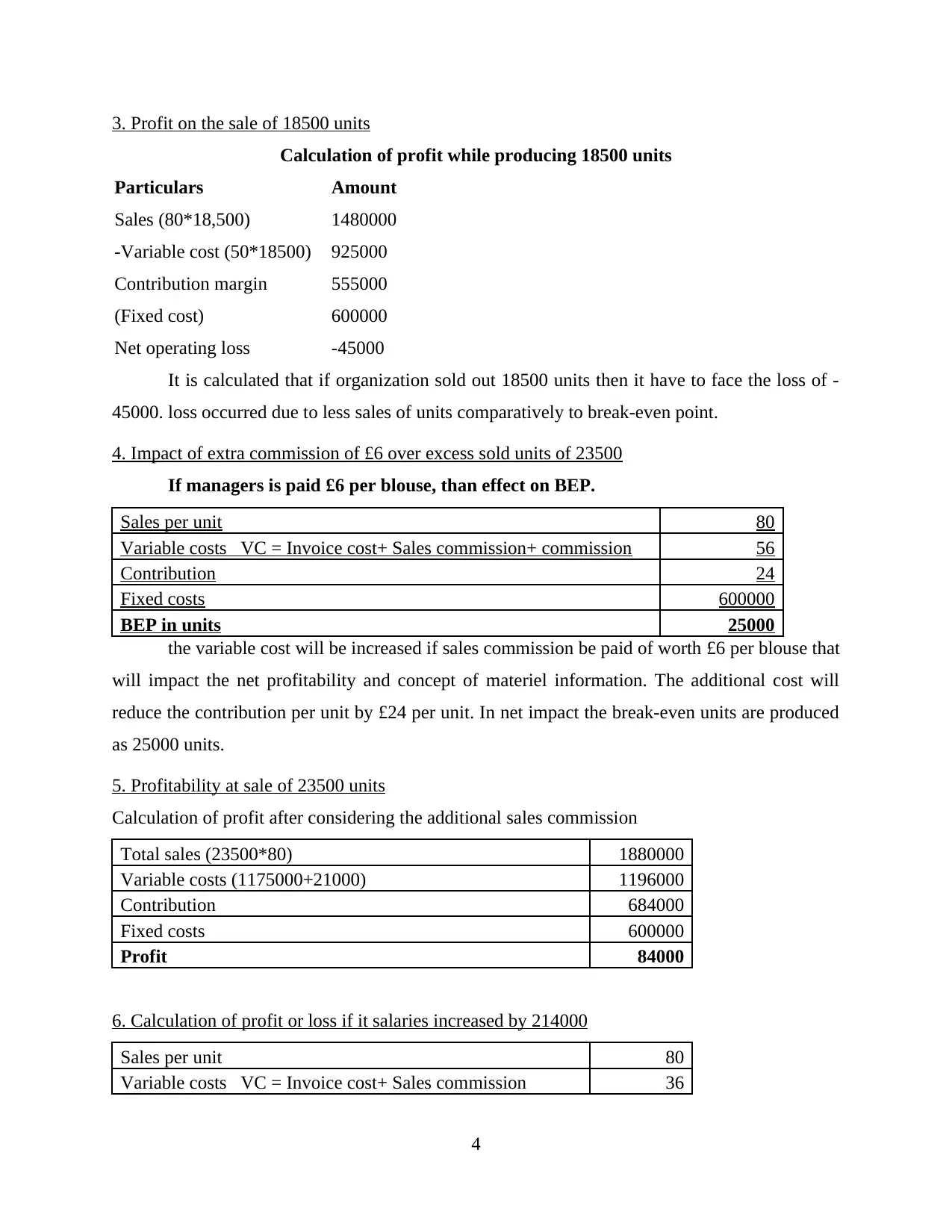
3. Profit on the sale of 18500 units
Calculation of profit while producing 18500 units
Particulars Amount
Sales (80*18,500) 1480000
-Variable cost (50*18500) 925000
Contribution margin 555000
(Fixed cost) 600000
Net operating loss -45000
It is calculated that if organization sold out 18500 units then it have to face the loss of -
45000. loss occurred due to less sales of units comparatively to break-even point.
4. Impact of extra commission of £6 over excess sold units of 23500
If managers is paid £6 per blouse, than effect on BEP.
Sales per unit 80
Variable costs VC = Invoice cost+ Sales commission+ commission 56
Contribution 24
Fixed costs 600000
BEP in units 25000
the variable cost will be increased if sales commission be paid of worth £6 per blouse that
will impact the net profitability and concept of materiel information. The additional cost will
reduce the contribution per unit by £24 per unit. In net impact the break-even units are produced
as 25000 units.
5. Profitability at sale of 23500 units
Calculation of profit after considering the additional sales commission
Total sales (23500*80) 1880000
Variable costs (1175000+21000) 1196000
Contribution 684000
Fixed costs 600000
Profit 84000
6. Calculation of profit or loss if it salaries increased by 214000
Sales per unit 80
Variable costs VC = Invoice cost+ Sales commission 36
4
Calculation of profit while producing 18500 units
Particulars Amount
Sales (80*18,500) 1480000
-Variable cost (50*18500) 925000
Contribution margin 555000
(Fixed cost) 600000
Net operating loss -45000
It is calculated that if organization sold out 18500 units then it have to face the loss of -
45000. loss occurred due to less sales of units comparatively to break-even point.
4. Impact of extra commission of £6 over excess sold units of 23500
If managers is paid £6 per blouse, than effect on BEP.
Sales per unit 80
Variable costs VC = Invoice cost+ Sales commission+ commission 56
Contribution 24
Fixed costs 600000
BEP in units 25000
the variable cost will be increased if sales commission be paid of worth £6 per blouse that
will impact the net profitability and concept of materiel information. The additional cost will
reduce the contribution per unit by £24 per unit. In net impact the break-even units are produced
as 25000 units.
5. Profitability at sale of 23500 units
Calculation of profit after considering the additional sales commission
Total sales (23500*80) 1880000
Variable costs (1175000+21000) 1196000
Contribution 684000
Fixed costs 600000
Profit 84000
6. Calculation of profit or loss if it salaries increased by 214000
Sales per unit 80
Variable costs VC = Invoice cost+ Sales commission 36
4
⊘ This is a preview!⊘
Do you want full access?
Subscribe today to unlock all pages.

Trusted by 1+ million students worldwide
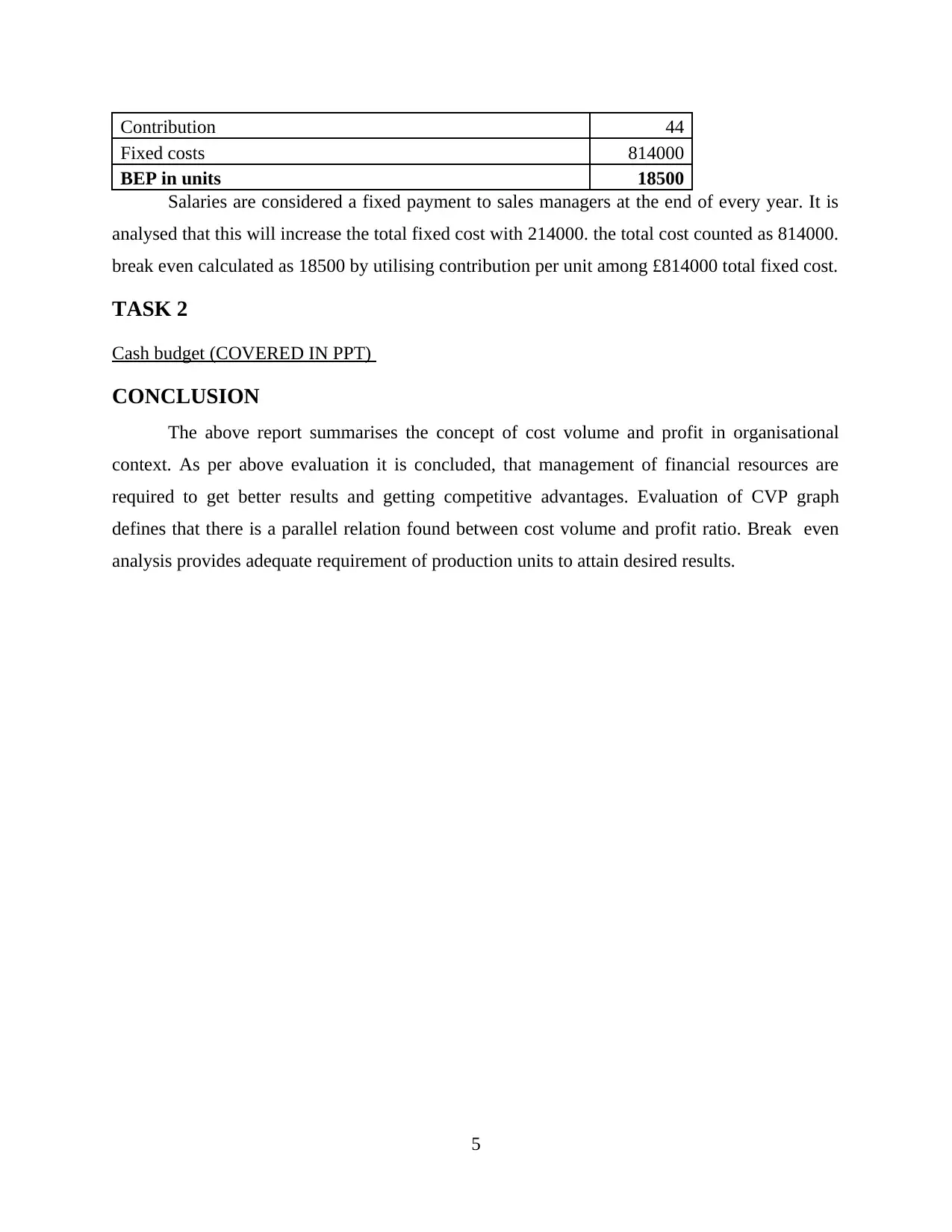
Contribution 44
Fixed costs 814000
BEP in units 18500
Salaries are considered a fixed payment to sales managers at the end of every year. It is
analysed that this will increase the total fixed cost with 214000. the total cost counted as 814000.
break even calculated as 18500 by utilising contribution per unit among £814000 total fixed cost.
TASK 2
Cash budget (COVERED IN PPT)
CONCLUSION
The above report summarises the concept of cost volume and profit in organisational
context. As per above evaluation it is concluded, that management of financial resources are
required to get better results and getting competitive advantages. Evaluation of CVP graph
defines that there is a parallel relation found between cost volume and profit ratio. Break even
analysis provides adequate requirement of production units to attain desired results.
5
Fixed costs 814000
BEP in units 18500
Salaries are considered a fixed payment to sales managers at the end of every year. It is
analysed that this will increase the total fixed cost with 214000. the total cost counted as 814000.
break even calculated as 18500 by utilising contribution per unit among £814000 total fixed cost.
TASK 2
Cash budget (COVERED IN PPT)
CONCLUSION
The above report summarises the concept of cost volume and profit in organisational
context. As per above evaluation it is concluded, that management of financial resources are
required to get better results and getting competitive advantages. Evaluation of CVP graph
defines that there is a parallel relation found between cost volume and profit ratio. Break even
analysis provides adequate requirement of production units to attain desired results.
5
Paraphrase This Document
Need a fresh take? Get an instant paraphrase of this document with our AI Paraphraser
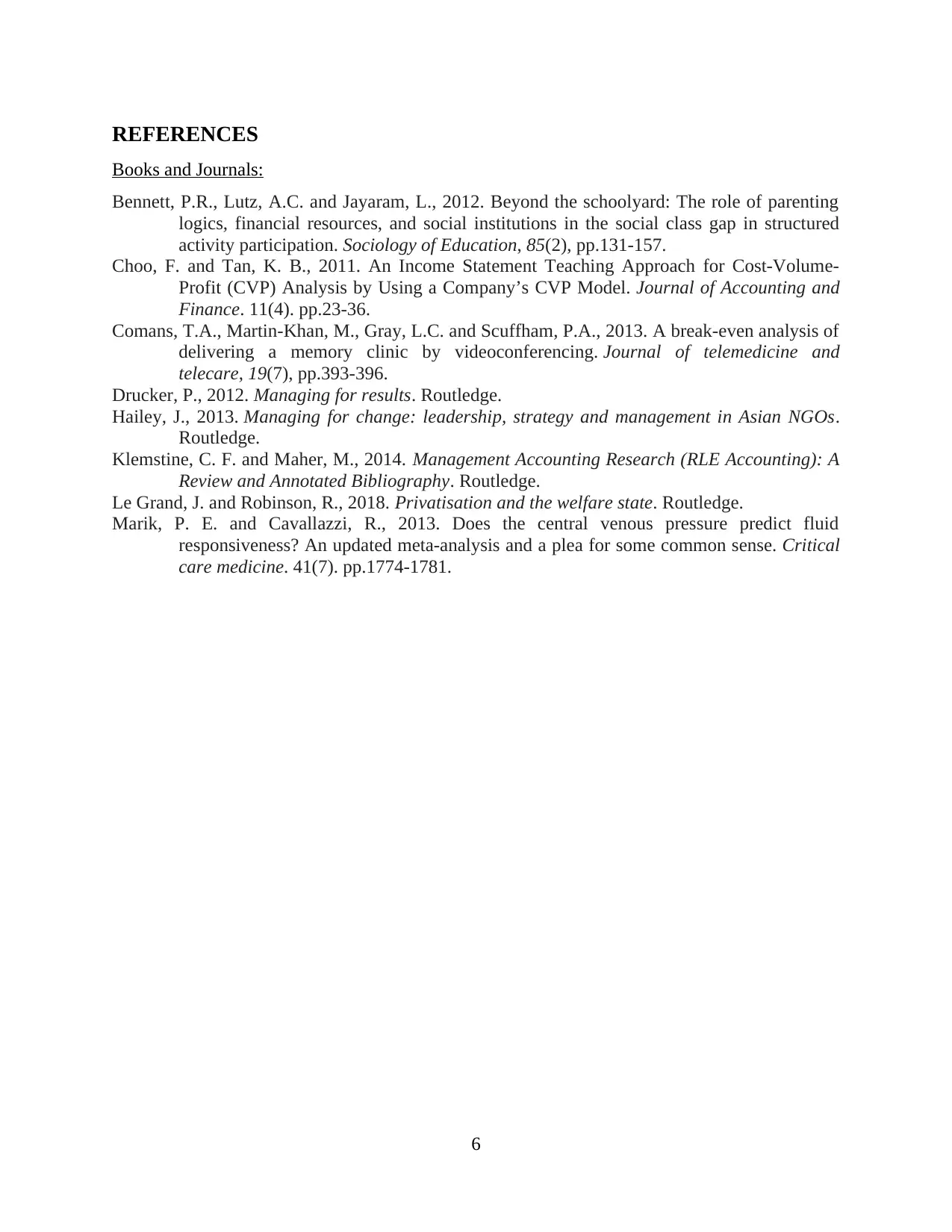
REFERENCES
Books and Journals:
Bennett, P.R., Lutz, A.C. and Jayaram, L., 2012. Beyond the schoolyard: The role of parenting
logics, financial resources, and social institutions in the social class gap in structured
activity participation. Sociology of Education, 85(2), pp.131-157.
Choo, F. and Tan, K. B., 2011. An Income Statement Teaching Approach for Cost-Volume-
Profit (CVP) Analysis by Using a Company’s CVP Model. Journal of Accounting and
Finance. 11(4). pp.23-36.
Comans, T.A., Martin-Khan, M., Gray, L.C. and Scuffham, P.A., 2013. A break-even analysis of
delivering a memory clinic by videoconferencing. Journal of telemedicine and
telecare, 19(7), pp.393-396.
Drucker, P., 2012. Managing for results. Routledge.
Hailey, J., 2013. Managing for change: leadership, strategy and management in Asian NGOs.
Routledge.
Klemstine, C. F. and Maher, M., 2014. Management Accounting Research (RLE Accounting): A
Review and Annotated Bibliography. Routledge.
Le Grand, J. and Robinson, R., 2018. Privatisation and the welfare state. Routledge.
Marik, P. E. and Cavallazzi, R., 2013. Does the central venous pressure predict fluid
responsiveness? An updated meta-analysis and a plea for some common sense. Critical
care medicine. 41(7). pp.1774-1781.
6
Books and Journals:
Bennett, P.R., Lutz, A.C. and Jayaram, L., 2012. Beyond the schoolyard: The role of parenting
logics, financial resources, and social institutions in the social class gap in structured
activity participation. Sociology of Education, 85(2), pp.131-157.
Choo, F. and Tan, K. B., 2011. An Income Statement Teaching Approach for Cost-Volume-
Profit (CVP) Analysis by Using a Company’s CVP Model. Journal of Accounting and
Finance. 11(4). pp.23-36.
Comans, T.A., Martin-Khan, M., Gray, L.C. and Scuffham, P.A., 2013. A break-even analysis of
delivering a memory clinic by videoconferencing. Journal of telemedicine and
telecare, 19(7), pp.393-396.
Drucker, P., 2012. Managing for results. Routledge.
Hailey, J., 2013. Managing for change: leadership, strategy and management in Asian NGOs.
Routledge.
Klemstine, C. F. and Maher, M., 2014. Management Accounting Research (RLE Accounting): A
Review and Annotated Bibliography. Routledge.
Le Grand, J. and Robinson, R., 2018. Privatisation and the welfare state. Routledge.
Marik, P. E. and Cavallazzi, R., 2013. Does the central venous pressure predict fluid
responsiveness? An updated meta-analysis and a plea for some common sense. Critical
care medicine. 41(7). pp.1774-1781.
6
1 out of 8
Related Documents
Your All-in-One AI-Powered Toolkit for Academic Success.
+13062052269
info@desklib.com
Available 24*7 on WhatsApp / Email
![[object Object]](/_next/static/media/star-bottom.7253800d.svg)
Unlock your academic potential
Copyright © 2020–2025 A2Z Services. All Rights Reserved. Developed and managed by ZUCOL.





